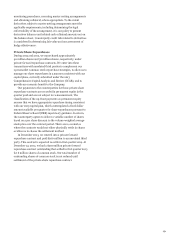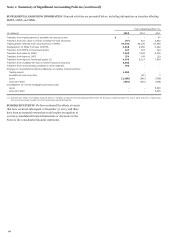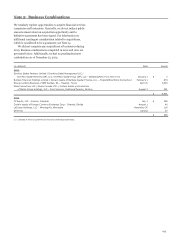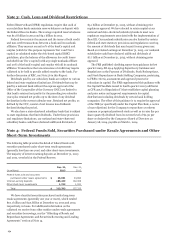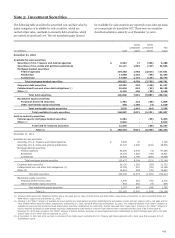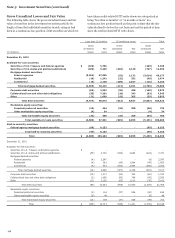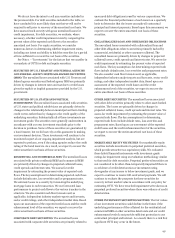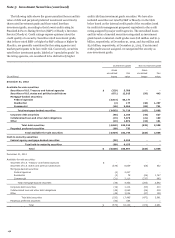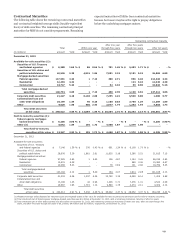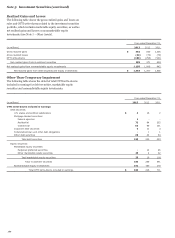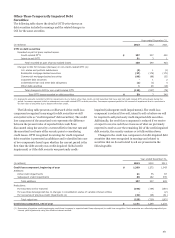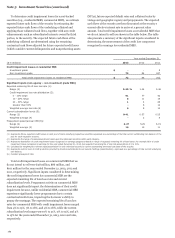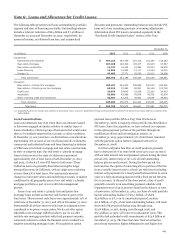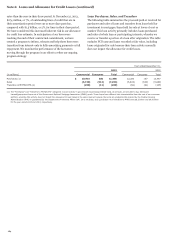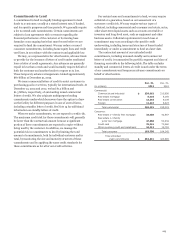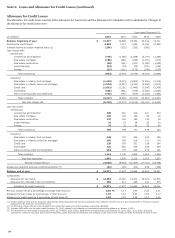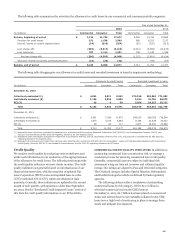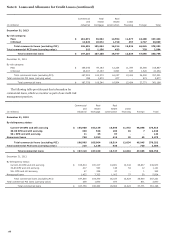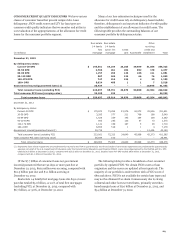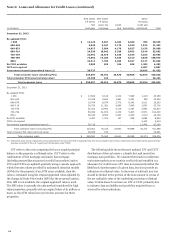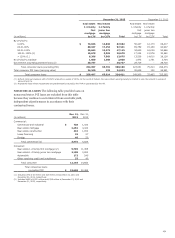Wells Fargo 2013 Annual Report Download - page 163
Download and view the complete annual report
Please find page 163 of the 2013 Wells Fargo annual report below. You can navigate through the pages in the report by either clicking on the pages listed below, or by using the keyword search tool below to find specific information within the annual report.
Other-Than-Temporarily Impaired Debt
Securities
The following table shows the detail of OTTI write-downs on
debt securities included in earnings and the related changes in
OCI for the same securities.
Year ended December 31,
(in millions) 2013 2012 2011
OTTI on debt securities
Recorded as part of gross realized losses:
Credit-related OTTI $ 107 237 422
Intent-to-sell OTTI 51 3 1
Total recorded as part of gross realized losses 158 240 423
Changes to OCI for increase (decrease) in non-credit-related OTTI (1):
U.S. states and political subdivisions (2) 1 (1)
Residential mortgage-backed securities (27) (178) (171)
Commercial mortgage-backed securities (90) (88) 105
Corporate debt securities - 1 2
Collateralized loan and other debt obligations (1) (1) 4
Other debt securities 1 28 (13)
Total changes to OCI for non-credit-related OTTI (119) (237) (74)
Total OTTI losses recorded on debt securities $ 39 3 349
(1) Represents amounts recorded to OCI for impairment, due to factors other than credit, on debt securities that have also had credit-related OTTI write-downs during the
period. Increases represent initial or subsequent non-credit-related OTTI on debt securities. Decreases represent partial to full reversal of impairment due to recoveries in
the fair value of securities due to factors other than credit.
The following table presents a rollforward of the credit loss
component recognized in earnings for debt securities we still
own (referred to as “credit-impaired” debt securities). The credit
loss component of the amortized cost represents the difference
between the present value of expected future cash flows
discounted using the security’s current effective interest rate and
the amortized cost basis of the security prior to considering
credit losses. OTTI recognized in earnings for credit-impaired
debt securities is presented as additions and is classified into one
of two components based upon whether the current period is the
first time the debt security was credit-impaired (initial credit
impairment) or if the debt security was previously credit-
impaired (subsequent credit impairments). The credit loss
component is reduced if we sell, intend to sell or believe we will
be required to sell previously credit-impaired debt securities.
Additionally, the credit loss component is reduced if we receive
or expect to receive cash flows in excess of what we previously
expected to receive over the remaining life of the credit-impaired
debt security, the security matures or is fully written down.
Changes in the credit loss component of credit-impaired debt
securities that were recognized in earnings and related to
securities that we do not intend to sell are presented in the
following table.
Year ended December 31,
(in millions) 2013 2012 2011
Credit loss component, beginning of year $ 1,289 1,272 1,043
Additions:
Initial credit impairments 21 55 87
Subsequent credit impairments 86 182 335
Total additions 107 237 422
Reductions:
For securities sold or matured (194) (194) (160)
For securities derecognized due to changes in consolidation status of variable interest entities - - (2)
For recoveries of previous credit impairments (1) (31) (26) (31)
Total reductions (225) (220) (193)
Credit loss component, end of year $ 1,171 1,289 1,272
(1) Recoveries of previous credit impairments result from increases in expected cash flows subsequent to credit loss recognition. Such recoveries are reflected prospectively as
interest yield adjustments using the effective interest method.
161


